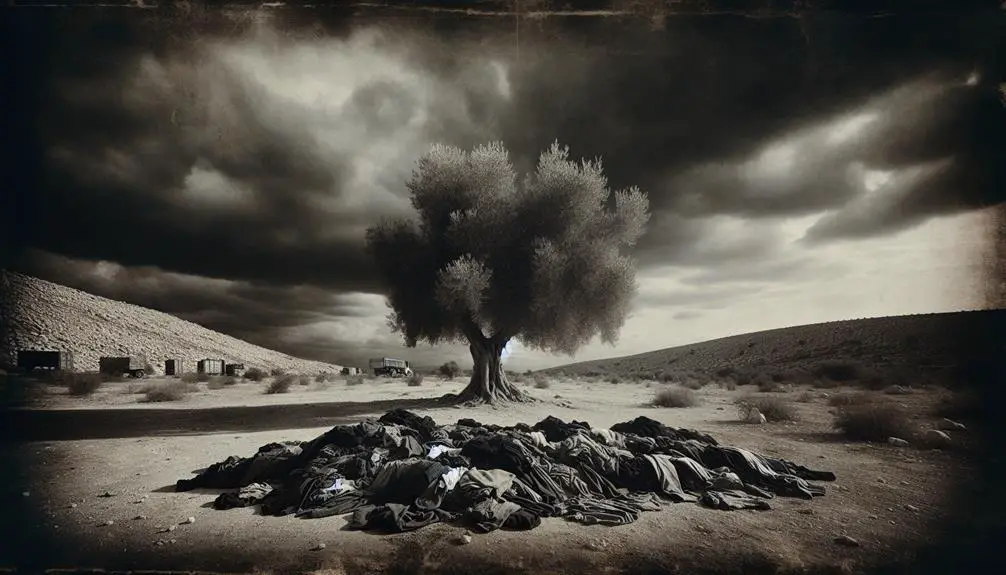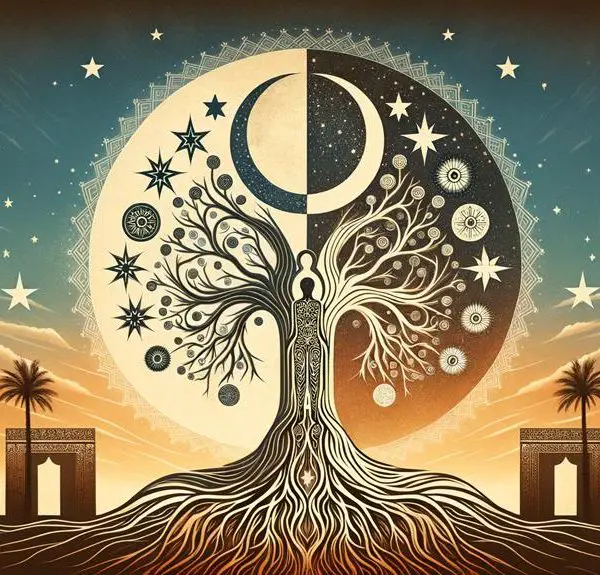Peek into the biblical symbolism of gray to uncover its deep meanings in wisdom, mourning, and prophecy, revealing layers beyond the surface.

Gray in the Bible
In the biblical palette, gray isn't just for donkeys and ashes; it's a color with a surprisingly rich symbolism that you've likely glossed over during your Sunday school lessons. From embodying wisdom and age to signifying mourning and humility, gray weaves a complex narrative across the scriptures.
But beyond its role in fabric and fauna, gray's rarity and significance in prophetic visions offer a tantalizing glimpse into the biblical authors' minds. As you explore these hues more closely, you'll uncover layers of meaning that might just change the way you view the ancient texts.
Key Takeaways
- Gray symbolizes wisdom, the complexity of the human condition, and the transition between life and death in biblical narratives.
- It reflects mourning and loss, often represented in attire to express sorrow and mark communal mourning practices.
- The presence of gray, especially in hair, indicates esteem for age, wisdom, and the accumulation of life's experiences and lessons.
- In prophecy and divine imagery, gray signals significant divine interventions, judgments, and transformations, emphasizing its rare but profound symbolism.
Symbolism of Gray

In biblical texts, gray often symbolizes wisdom, dignity, and the transition between life and death, reflecting its multifaceted significance in religious narratives. This color neutrality plays a pivotal role in illustrating complex spiritual states and themes. Unlike colors that evoke strong, singular emotions or moral judgements, gray's ambiguity fosters a space for reflection and deeper understanding of the spiritual journey.
The notion of spiritual ambiguity associated with gray is particularly compelling. It doesn't commit to the starkness of black or the purity of white, but rather, it exists in a liminal space that invites contemplation. This ambiguity can be interpreted as a representation of the human condition, embodying the mix of sin and purity, ignorance and enlightenment, mortality and eternity that characterize the spiritual experience.
Moreover, the association of gray with wisdom and dignity emphasizes the value of age and experience in gaining spiritual insight. It suggests that understanding and reconciling with the complexities of life, including its inevitable end, are integral to spiritual growth and enlightenment. Gray, therefore, not only marks the physical aging process but also symbolizes the accumulation of spiritual knowledge over time.
Gray and Mourning

Gray's association with mourning reflects its profound role in symbolizing grief and loss within biblical contexts. When you explore the narrative and descriptive layers of biblical texts, you'll notice that gray attire frequently emerges as a visual and symbolic representation of mourning. This choice of color isn't arbitrary but deeply embedded in the cultural and religious practices of the time, serving as an outward manifestation of inner sorrow and despair.
As you delve deeper, you encounter instances where characters don garb in shades of gray as a form of emotional expression, signaling to others their state of bereavement. This practice underlines the communal aspect of mourning in biblical times, where personal grief intertwines with collective expressions of loss.
Moreover, the use of gray transcends mere clothing; it often permeates the narrative ambiance, setting a somber tone that mirrors the emotional landscape of the characters involved. This careful integration of gray into the text highlights its significance not just as a color but as a conduit for conveying the depths of human emotion in times of profound sorrow.
Wisdom and Age

Why does the Bible often equate gray hair with wisdom and experience, marking a profound respect for the aged within its texts? This question delves into the intersection of gray perception and cultural influences, which have shaped the way societies view aging. The Bible, as a foundational document for many, reflects and reinforces the esteem held for the elderly, associating the accumulation of years with an accumulation of knowledge and insight. This correlation isn't merely anecdotal; it's woven into the fabric of biblical narratives and teachings, suggesting a deliberate choice to valorize age as a source of authority and reverence.
Analyzing this through a scholarly lens, one must consider the historical context in which these texts were written. In ancient times, the survival to an old age was a significant achievement, often indicating not just physical resilience but a life rich in experiences and lessons. The gray hair of the elderly symbolized a life journey filled with trials, learning, and wisdom worthy of respect and attention. This cultural influence, deeply embedded in biblical texts, underscores a broader human inclination to associate age with wisdom, guiding societal attitudes and perceptions of aging and respect across generations.
Gray in Prophecy

Shifting focus to the realm of prophecy, the Bible's portrayal of gray not only symbolizes wisdom and experience but also plays a significant role in prophetic imagery and messages. When you delve deeper into biblical prophecies, you'll discover that gray often appears as a harbinger of significant, sometimes apocalyptic events. These gray omens serve as visual cues, emphasizing the seriousness and the monumental nature of the prophecies they accompany.
Here's a brief overview of how gray manifests in biblical prophecy:
Aspect |
Description |
Biblical References |
|---|---|---|
Apocalyptic Imagery |
Gray often appears in visions that depict end times or judgment, symbolizing the bleakness and uncertainty of these periods. |
Isaiah 13:9-10 |
Gray Omens |
The appearance of gray can signal divine intervention or impending change, marking a transition from one era to another. |
Ezekiel 37:1-14 |
Symbolism |
In prophetic literature, gray may symbolize the wisdom required to interpret the times or the moral ambiguity of certain situations. |
Zechariah 6:1-8 |
Analyzing these instances, it's clear that gray's inclusion in prophecy is neither arbitrary nor superficial. It's intricately linked with themes of transformation, judgment, and the divine orchestration of history, offering a nuanced understanding of its role in biblical narratives.
Gray's Rarity and Significance

In the biblical narrative, the occurrence of gray isn't only scarce but carries profound symbolism, reflecting its unique significance in the text. This rarity underscores the meticulous choice of colors in the scriptures, where each shade holds specific connotations. Gray, when mentioned, is often enveloped in layers of metaphor and meaning, distinguishing it from more frequently cited colors.
The analytical examination of gray's occurrence reveals several key aspects of its significance:
- Visual Descriptions: Gray serves to paint a vivid picture, aiding in the immersion and understanding of the biblical world. It's not just a color but a tool for storytelling, enhancing the narrative's depth.
- Color Interpretation: The interpretation of gray within the biblical context goes beyond its surface value, symbolizing complexity, neutrality, or transition. It invites readers to delve into a deeper understanding of the text.
- Symbolic Meanings: In some instances, gray signifies age, wisdom, or sorrow, embodying the human experience's multifaceted nature.
- Cultural Significance: The biblical use of gray also reflects the historical and cultural backdrop of the times, offering insights into ancient perceptions of color and its symbolic weight.
Understanding gray's rarity and significance in the Bible enriches one's grasp of biblical symbolism and color interpretation, highlighting the sophisticated use of visual descriptions in conveying deeper meanings.
Frequently Asked Questions
How Do Modern Translations of the Bible Differ in Their Interpretation of the Color Gray Compared to Older Translations?
You've noticed that modern translations of texts often shift in their interpretation of colors, like gray, due to translation methods and linguistic evolution. These changes aren't arbitrary; they reflect deeper understandings of language and culture.
As translation techniques become more sophisticated and linguists delve further into historical contexts, the nuances in color interpretation shift. This evolution in translation methodologies ensures a more accurate and culturally relevant understanding of texts over time.
Are There Any Specific Biblical Figures Who Are Directly Associated With the Color Gray, Outside of Its Symbolic Meanings?
You're wondering if there are biblical figures tied to the color gray, beyond its symbolic meanings.
Direct associations are rare. However, gray animals and gray garments occasionally appear in narratives, but they're not typically linked to specific individuals in a symbolic manner.
Instead, these references might serve more to describe scenes or offerings rather than to characterize people.
In What Ways Have Contemporary Biblical Scholars Critiqued or Expanded Upon Traditional Interpretations of Gray in the Bible?
Contemporary scholars have delved into color psychology and textual symbolism to reinterpret traditional biblical narratives. By examining gray's nuances, they've uncovered deeper layers of meaning, challenging and enriching our understanding.
This analytical approach doesn't just question old interpretations; it invites you to see familiar stories in new light. Through scholarly critique, you're encouraged to appreciate the complexity of biblical texts, where gray isn't just a color—it's a symbol with evolving interpretations.
Can the Use of Gray in Biblical Texts Be Linked to Cultural or Historical Perspectives on Color From the Regions and Periods in Which These Texts Were Written?
Absolutely, the use of color symbolism in ancient texts, including gray, can reflect the cultural or historical attitudes toward color in the societies that produced these texts.
Regional influences significantly shaped how colors were perceived and symbolized, offering insights into societal norms and values.
When you delve into these texts, you're essentially unpacking layers of historical and cultural perspectives that have been woven into the narrative through the deliberate choice of colors like gray.
How Have Different Christian Denominations and Other Religions That Reference the Bible Interpreted the Significance of the Color Gray in Their Religious Practices and Teachings?
Imagine you're exploring how religions view gray symbolism, especially in their teachings.
Different Christian denominations and religions referencing the Bible interpret gray's significance uniquely, influenced by color psychology.
For instance, one might see it as representing neutrality or wisdom, reflecting deeper theological interpretations.
Analytically, these perspectives offer insights into how religious practices and beliefs are shaped, not just by sacred texts but also by the cultural and historical context of color interpretation.
Conclusion
In the tapestry of biblical narrative, gray emerges not merely as a color, but as a profound symbol interwoven with life's intricate patterns. It juxtaposes mourning with wisdom, scarcity with significance, weaving a rich, complex message.
Through the lens of prophecy and age, gray embodies both the solemnity of loss and the venerable touch of time's passage. This duality invites reflection, urging you to ponder life's fleeting moments and the enduring wisdom they bequeath.
Gray, thus, transcends mere hue, becoming a narrative of human experience itself.



Sign up